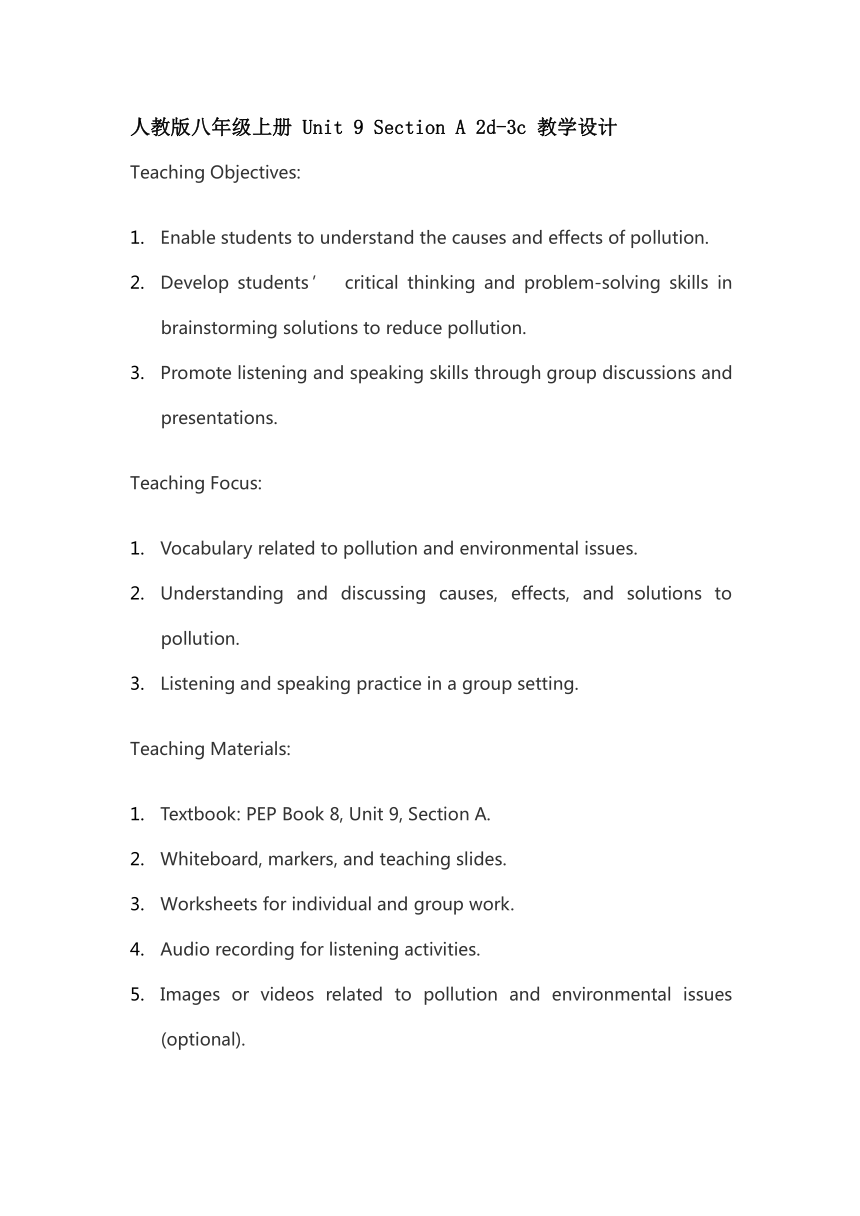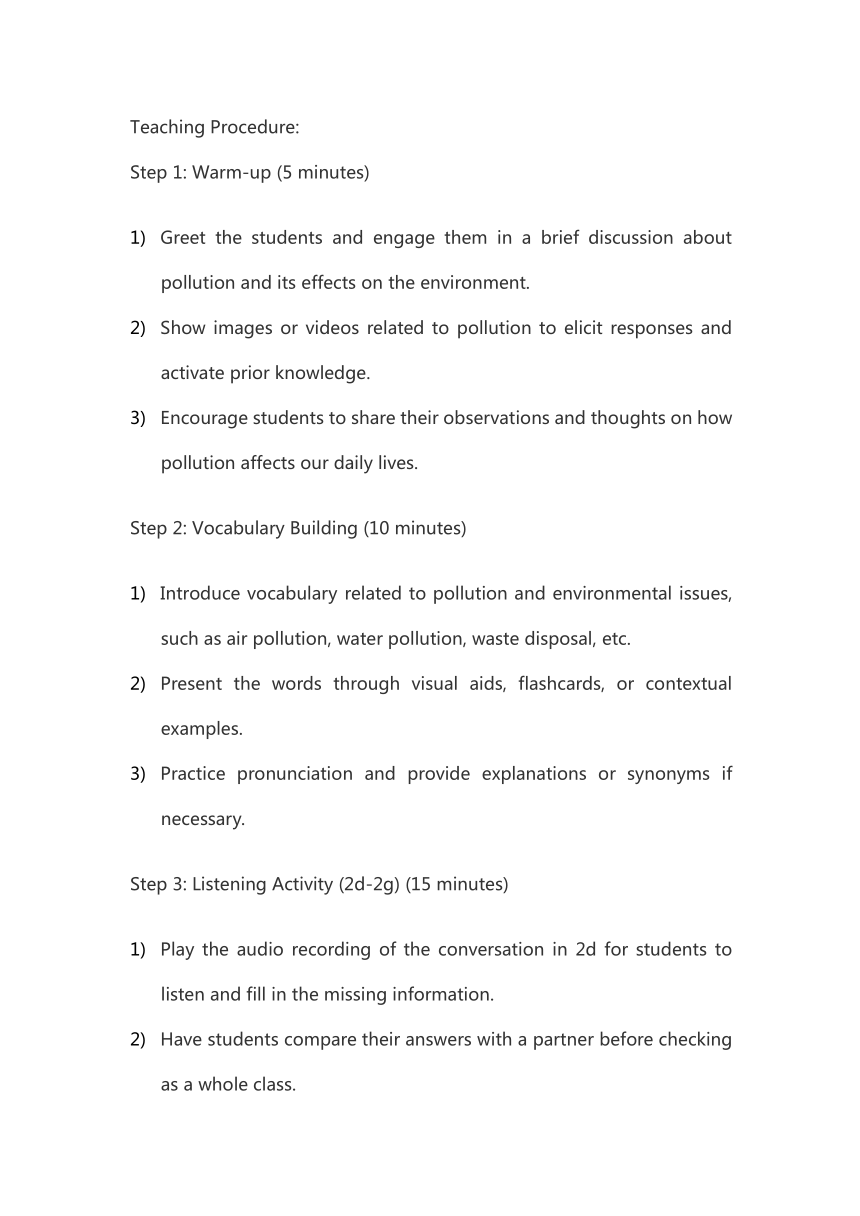人教版八年级上册Unit9 Can you come to my party?Section A 2d-3c 教学设计
文档属性
| 名称 | 人教版八年级上册Unit9 Can you come to my party?Section A 2d-3c 教学设计 |  | |
| 格式 | docx | ||
| 文件大小 | 16.4KB | ||
| 资源类型 | 教案 | ||
| 版本资源 | 人教新目标(Go for it)版 | ||
| 科目 | 英语 | ||
| 更新时间 | 2023-07-17 20:54:12 | ||
图片预览


文档简介
人教版八年级上册 Unit 9 Section A 2d-3c 教学设计
Teaching Objectives:
Enable students to understand the causes and effects of pollution.
Develop students’ critical thinking and problem-solving skills in brainstorming solutions to reduce pollution.
Promote listening and speaking skills through group discussions and presentations.
Teaching Focus:
Vocabulary related to pollution and environmental issues.
Understanding and discussing causes, effects, and solutions to pollution.
Listening and speaking practice in a group setting.
Teaching Materials:
Textbook: PEP Book 8, Unit 9, Section A.
Whiteboard, markers, and teaching slides.
Worksheets for individual and group work.
Audio recording for listening activities.
Images or videos related to pollution and environmental issues (optional).
Teaching Procedure:
Step 1: Warm-up (5 minutes)
Greet the students and engage them in a brief discussion about pollution and its effects on the environment.
Show images or videos related to pollution to elicit responses and activate prior knowledge.
Encourage students to share their observations and thoughts on how pollution affects our daily lives.
Step 2: Vocabulary Building (10 minutes)
Introduce vocabulary related to pollution and environmental issues, such as air pollution, water pollution, waste disposal, etc.
Present the words through visual aids, flashcards, or contextual examples.
Practice pronunciation and provide explanations or synonyms if necessary.
Step 3: Listening Activity (2d-2g) (15 minutes)
Play the audio recording of the conversation in 2d for students to listen and fill in the missing information.
Have students compare their answers with a partner before checking as a whole class.
Discuss the answers, focusing on the causes and effects of pollution mentioned in the conversation.
Step 4: Group Discussion (3a-3b) (20 minutes)
Divide students into small groups.
Provide each group with a worksheet containing the discussion questions in 3a-3b.
In their groups, students discuss the questions and brainstorm possible solutions to reduce pollution.
Monitor the groups, provide support, and encourage participation from all members.
After the discussions, ask each group to share their ideas with the class.
Step 5: Group Presentation (3c) (15 minutes)
Instruct each group to choose one or two of their proposed solutions to pollution.
Ask each group to prepare a short presentation explaining their chosen solutions and why they believe these solutions are effective.
Each group presents their ideas to the class, emphasizing the benefits and feasibility of their proposed solutions.
Encourage the rest of the class to ask questions or provide feedback on the presentations.
Step 6: Summary and Closure (5 minutes)
Summarize the key points discussed during the lesson, highlighting the causes, effects, and possible solutions to pollution.
Encourage students to reflect on their own actions and how they can contribute to reducing pollution on a personal level.
Assign homework that further explores environmental issues, such as writing an essay on the topic or researching a specific aspect of pollution.
Teaching Reflection:
This lesson plan aims to increase students’ awareness and understanding of pollution, its causes, effects, and possible solutions. The lesson emphasizes active participation through group discussions and presentations, promoting critical thinking and problem-solving skills. By incorporating listening activities, vocabulary building, and collaborative work, students have the opportunity to apply their knowledge in real-life situations and engage in meaningful conversations. Continuous monitoring and feedback will ensure students’ comprehension and active participation throughout the lesson
Teaching Objectives:
Enable students to understand the causes and effects of pollution.
Develop students’ critical thinking and problem-solving skills in brainstorming solutions to reduce pollution.
Promote listening and speaking skills through group discussions and presentations.
Teaching Focus:
Vocabulary related to pollution and environmental issues.
Understanding and discussing causes, effects, and solutions to pollution.
Listening and speaking practice in a group setting.
Teaching Materials:
Textbook: PEP Book 8, Unit 9, Section A.
Whiteboard, markers, and teaching slides.
Worksheets for individual and group work.
Audio recording for listening activities.
Images or videos related to pollution and environmental issues (optional).
Teaching Procedure:
Step 1: Warm-up (5 minutes)
Greet the students and engage them in a brief discussion about pollution and its effects on the environment.
Show images or videos related to pollution to elicit responses and activate prior knowledge.
Encourage students to share their observations and thoughts on how pollution affects our daily lives.
Step 2: Vocabulary Building (10 minutes)
Introduce vocabulary related to pollution and environmental issues, such as air pollution, water pollution, waste disposal, etc.
Present the words through visual aids, flashcards, or contextual examples.
Practice pronunciation and provide explanations or synonyms if necessary.
Step 3: Listening Activity (2d-2g) (15 minutes)
Play the audio recording of the conversation in 2d for students to listen and fill in the missing information.
Have students compare their answers with a partner before checking as a whole class.
Discuss the answers, focusing on the causes and effects of pollution mentioned in the conversation.
Step 4: Group Discussion (3a-3b) (20 minutes)
Divide students into small groups.
Provide each group with a worksheet containing the discussion questions in 3a-3b.
In their groups, students discuss the questions and brainstorm possible solutions to reduce pollution.
Monitor the groups, provide support, and encourage participation from all members.
After the discussions, ask each group to share their ideas with the class.
Step 5: Group Presentation (3c) (15 minutes)
Instruct each group to choose one or two of their proposed solutions to pollution.
Ask each group to prepare a short presentation explaining their chosen solutions and why they believe these solutions are effective.
Each group presents their ideas to the class, emphasizing the benefits and feasibility of their proposed solutions.
Encourage the rest of the class to ask questions or provide feedback on the presentations.
Step 6: Summary and Closure (5 minutes)
Summarize the key points discussed during the lesson, highlighting the causes, effects, and possible solutions to pollution.
Encourage students to reflect on their own actions and how they can contribute to reducing pollution on a personal level.
Assign homework that further explores environmental issues, such as writing an essay on the topic or researching a specific aspect of pollution.
Teaching Reflection:
This lesson plan aims to increase students’ awareness and understanding of pollution, its causes, effects, and possible solutions. The lesson emphasizes active participation through group discussions and presentations, promoting critical thinking and problem-solving skills. By incorporating listening activities, vocabulary building, and collaborative work, students have the opportunity to apply their knowledge in real-life situations and engage in meaningful conversations. Continuous monitoring and feedback will ensure students’ comprehension and active participation throughout the lesson
同课章节目录
- Unit 1 Where did you go on vacation?
- Section A
- Section B
- Unit 2 How often do you exercise?
- Section A
- Section B
- Unit 3 I'm more outgoing than my sister.
- Section A
- Section B
- Unit 4 What's the best movie theater?
- Section A
- Section B
- Unit 5 Do you want to watch a game show?
- Section A
- Section B
- Unit 6 I'm going to study computer science.
- Section A
- Section B
- Unit 7 Will people have robots?
- Section A
- Section B
- Unit 8 How do you make a banana milk shake?
- Section A
- Section B
- Unit 9 Can you come to my party?
- Section A
- Section B
- Unit 10 If you go to the party, you'll have a grea
- Section A
- Section B
